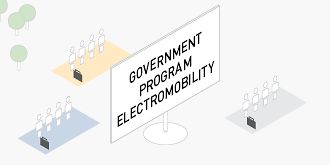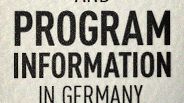The NPE has established six R&D lighthouse projects which are already successfully up and running. In line with NPE proposals, a number of technology research areas were consolidated into existing projects to create the respective R&D lighthouse projects.
Batteries
The batteries R&D lighthouse project has been created to help Germany realize its stated aim of being a global leader in cell and battery technology with an integrated domestic manufacturing capability by 2020. The NPE has identified five thematic research priority areas in close consultation with industry, the research community and government. A total of 21 consortia have been formed. The consortia are made up of actors from industry and research communities.
The research priorities assigned the different consortia have been derived from the NPE’s first report.
The first thematic priority is focused on optimizing cell components. The second thematic research priority concerns the development of cost-effective and optimal performance post-Lithium ion technologies.
The third thematic research area addresses safety and testing equipment and procedures. The fourth research priority will investigate aging mechanisms and smart control designs in order to increase efficiency levels. The fifth research priority area concerns the testing of process technologies for mass production in order to identify the appropriate production technology for large-scale production purposes.
Individual consortia have been assessed in terms of their place in the value chain in order to address Germany’s stated lead supplier goal. The different projects represent all stages of the value chain and help establish a new quality standard across the entire system.
A two-pronged strategy has been adopted in accordance with the NPE principle of multiple technology deployment. Lithium-ion technology constitutes the first component or pillar of activity, with post-lithium ion technologies (such as lithium-sulfur, zinc-air, and lithium-air) constituting the second post-2025 period component.
Successful implementation of the battery R&D strategy will allow meaningful progress to be made towards establishing integrated cell and battery system manufacturing capability in Germany.
Drive Technologies and Vehicle Integration
Detailed drive and vehicle integration technology road maps for the R&D lighthouse projects in the fields of highly integrated drive systems (including on-board charging technology), electric motors, and power electronics/inverters were drawn up as part of the NPE’s second report published in 2011.
The resulting projects will prioritize research in the areas of improving cost efficiencies and increasing production volumes, improving power density and power-to-weight ratios and enhancing efficiency, quality and reliability.
Thirty-four new proposals have been consolidated within concrete projects which are now being implemented. Added to existing funding of approximately EUR 530 million, new project funding of EUR 340 million brings total project funding to around the EUR 870 million.
The resulting joint projects are made up of partnerships between research institutions, small and medium-sized businesses and major industry players.
Projects have been assigned two distinct categories:
- efficient, high-performance motor designs and materials
- cost-effective motor designs and materials.
As well as reducing vehicle cost, weight, and footprint, further projects will identify and evaluate designs for increasing power density, alternative electric motor technologies, and test procedure and specification standardization.
Power electronics projects within the drive technologies R&D lighthouse will examine ways of significantly reducing mass production systems costs for electric motors and associated power electronics. In drive systems, analysis of end-to-end optimization of efficiency, cost, weight, volume, and reliability of different power-train topologies is also being conducted.
Research projects concerning testing techniques in the field of manufacturing technologies have also been set up to assess quality assurance measures within the production process. Important research work is also being conducted in the field of integrated energy management in order to offset the increased power consumption effects of ancillary components due to, for example, seasonal change.
Network integration of electric vehicles into the transport and energy subsystems is a further area of drive technology R&D lighthouse activity.
Concrete results are already being yielded by the different drive technology R&D lighthouse projects, as project findings are implemented in production vehicle development. The domestic automotive sector (OEMs and suppliers) has announced more than 15 electric vehicle production runs planned over the next two to three years.
Lightweight Design
Although not explicitly singled out by the Government Program Electromobility as a lead technology area, it nevertheless enjoys high funding priority as a major cross-sectoral technology.
The lightweight design R&D lighthouse project is conducting research into new and modified materials on the way to functionally integrated systemic lightweight design. Activities have been defined in terms of four thematic research areas:
- Development of lightweight materials;
- Optimization and development of components;
- Development of lightweight electric vehicle structures;
- Industrial scale resource-efficient manufacturing processes.
The strategic import of lightweight design within the broader electric vehicle value chain is outlined by the number of research funding applications received. Over 90 separate applications were received, of which 15 were successful in obtaining R&D funding. According to the NPE, the potential created by adopting a systemic approach to the fundamental scientific and technical factors of lightweight design unfold in the adoption of a single, coherent approach to the different value process chains.
Recycling
Increased awareness of the need to reduce harmful emissions into the environment is seeing governments worldwide act to regulate permissible vehicle pollution levels. In 2009, the European Union (EU) and G8 member countries agreed to reduce CO2 emission levels by 80 percent by the year 2050. In order to meet this overall target, road transport must be decarbonized by a striking 95 percent over the same period.
These ambitious goals will only be achieved through creating new vehicle fuel efficiencies by developing sustainable drive train alternatives. Electric vehicles have a major role to play in safeguarding the environment. The NPE concludes that recycling represents a strategic pillar in the development of an environmentally, economically, and socially sustainable electric mobility industry.
The recycling R&D lighthouse project is made up of two thematic areas:
- Battery materials
- Power train component materials
A number of new components and materials are entering the value chain mix as lithium-ion batteries and alternative power trains are further developed. This in turn calls upon the introduction of new or modified recycling processes.
A further overarching theme - besides key materials recycling – is the safeguarding of raw material supply. Germany’s raw materials strategy is helping industry to secure raw material sources by establishing partnerships with a number of raw material-supplying countries.
Information and Communication Technology (ICT) and Infrastructure
The objective of the ICT and infrastructure R&D lighthouse projects is the development of charging and vehicle-to-grid (V2G) technologies as well as related communications processes and transactions.
The second report of the NPE identified four key thematic research areas for the ICT and Infrastructure R&D lighthouse. These are:
- Charging technologies;
- Power grid integration;
- ICT interfaces - energy systems;
- ICT interfaces - traffic systems.
R&D activities currently being conducted across these four areas take place within 15 broad-based consortia. At the time of writing, 17 further projects are currently being evaluated by the relevant government ministries.
Different charging (normal, fast, and inductive) technology progress to date can be tracked according to the NPE’s charging infrastructure technology roadmap (contained in an appendix of the second NPE report published in 2011).
Common interoperable processes and standard solutions are imperative to achieving acceptance within the driving public. Commercially viable fast-charging solutions (including DC and AC-based systems) are being developed by energy utilities, electrical engineering companies, automotive and battery manufactures for introduction within the showcase project regions. Fast chargers with up to 100 kW capacity - which will significantly reduce charging times - are being put through their paces for eventual implementation during the early mass-market phase.
The creation of common charging point and vehicle standards is essential to Germany’s 2020 objectives. The NPE endorses the German-American developed Combined Charging System (CCS) universal charging system.
In order to create a charging infrastructure that is fully integrated into the power grid, smart charging (grid-to-vehicle – G2V) and two-way power generation (V2G) models are being researched further, as are dynamic payment tariff models.
ICT-based energy and traffic system interfaces are being created along maximum process simplicity and transparency lines to promote user acceptance and generate appropriate business models. Research findings from the different model regions are being collated for further development in the respective showcase regions.
The energy sector is currently targeting a 90 percent level of fully accessible charging stations for all users by 2014.


